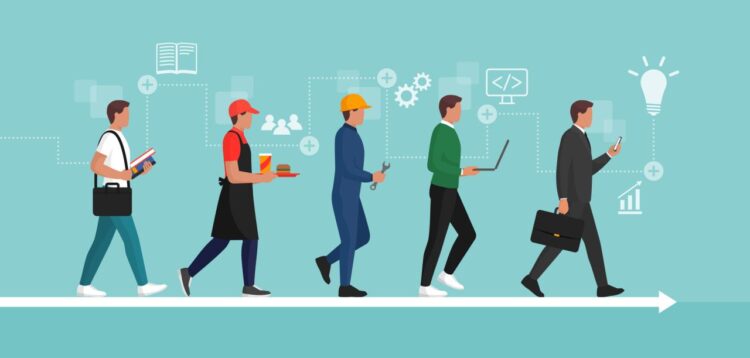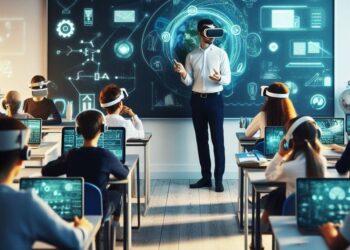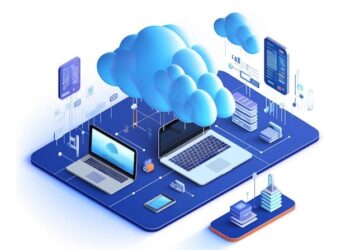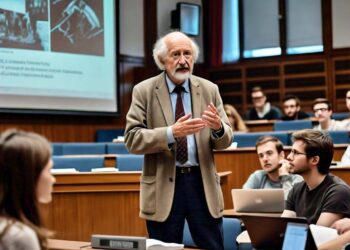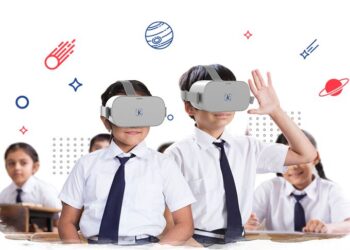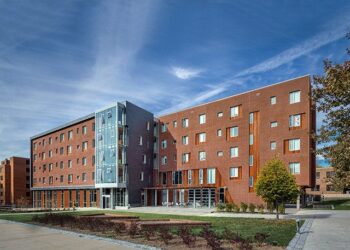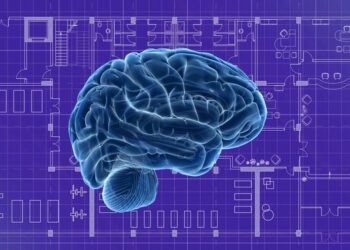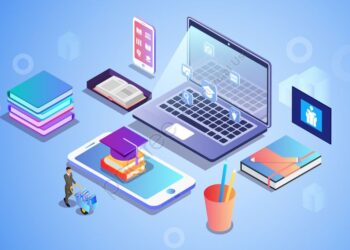The world is hurtling forward at an unprecedented pace, driven by technological revolutions like Artificial Intelligence (AI), automation, and global interconnectivity. This relentless change casts a long shadow of uncertainty over the future of work and, consequently, the very purpose of education. The traditional model, largely focused on rote memorization and standardized knowledge, is increasingly inadequate for preparing individuals for jobs that don’t yet exist and challenges we can barely imagine. To thrive in this unpredictable landscape, education must pivot towards future-proofing skills – a dynamic set of competencies that equip individuals not just to adapt, but to innovate, lead, and contribute meaningfully to a constantly evolving society. This article explores the essential skills required for this future, the shifts necessary in educational paradigms, and the strategies to ensure every learner is prepared for what lies ahead.
The Imperative of Future-Proofing Skills

The notion of a stable career path is rapidly becoming a relic of the past. Automation is reshaping industries, AI is augmenting human capabilities, and global challenges demand novel solutions. In this context, the skills that will remain valuable are those that machines cannot easily replicate – uniquely human attributes combined with the ability to continuously learn and adapt.
A. Why “Future-Proofing” is Critical:
The traditional education system often prepares students for a world that no longer exists. Future-proofing addresses this disconnect head-on.
- Rapid Technological Obsolescence: Technical skills acquired today might be outdated tomorrow. Education must foster the ability to constantly learn new technologies, rather than just mastering current ones.
- Automation and AI Displacement: Routine, repetitive tasks are increasingly being automated. This elevates the demand for skills that require human judgment, creativity, empathy, and complex problem-solving.
- Global Interconnectedness: Workforces are becoming more diverse and globally distributed, requiring strong cross-cultural communication and collaboration skills.
- Complex Global Challenges: Issues like climate change, pandemics, and social inequalities demand systemic thinking, innovative solutions, and interdisciplinary collaboration.
- Lifelong Learning as a Necessity: The idea of learning ending after formal schooling is obsolete. Individuals will need to continuously upskill and reskill throughout their careers to remain relevant.
B. The Core Pillars of Future-Proofing Skills:
While the specific list may evolve, several key categories consistently emerge as vital for navigating an uncertain future. These often overlap and reinforce each other.
- Critical Thinking and Problem-Solving:
- Analytical Reasoning: The ability to break down complex information, identify patterns, and evaluate arguments logically. This includes discerning credible information from misinformation in a data-rich world.
- Creative Problem-Solving: Moving beyond conventional solutions to generate novel and effective approaches to unforeseen challenges. This involves asking the right questions, reframing problems, and iterative experimentation.
- Decision-Making: The capacity to make sound judgments based on available data, ethical considerations, and an understanding of potential consequences.
- Creativity and Innovation:
- Original Thinking: Generating new ideas, concepts, and solutions that haven’t been considered before. This isn’t limited to artistic pursuits but is vital in science, business, and technology.
- Design Thinking: A human-centered approach to innovation that involves empathy, ideation, prototyping, and testing solutions.
- Adaptive Thinking: The ability to adjust strategies and approaches in response to new information or changing circumstances.
- Communication and Collaboration:
- Effective Verbal and Written Communication: Articulating complex ideas clearly, persuasively, and empathetically across various audiences and formats (presentations, reports, digital media).
- Active Listening: Truly understanding diverse perspectives and fostering open dialogue.
- Teamwork and Interpersonal Skills: Working effectively in diverse teams, resolving conflicts constructively, leveraging individual strengths, and building consensus. This includes both in-person and virtual collaboration.
- Digital Communication Fluency: Mastering various digital communication tools and understanding their appropriate use and etiquette.
- Digital Literacy and Computational Thinking:
- Technological Fluency: Comfort and proficiency in using various digital tools, platforms, and emerging technologies. This goes beyond basic operations to understanding their capabilities and limitations.
- Data Literacy: The ability to read, analyze, interpret, and communicate with data effectively, recognizing its potential and pitfalls (e.g., bias in algorithms).
- Computational Thinking: Breaking down problems into smaller parts, recognizing patterns, abstracting concepts, and designing step-by-step solutions that can be executed by humans or machines. This underpins coding and AI understanding.
- Cybersecurity Awareness: Understanding and practicing safe online behavior, protecting personal data, and recognizing digital threats.
- Adaptability and Resilience:
- Learning Agility: The willingness and capacity to continuously learn, unlearn, and relearn new skills and knowledge throughout life. This is perhaps the most critical “meta-skill.”
- Flexibility: Adjusting to new environments, roles, and challenges with an open mind.
- Resilience and Grit: Persevering through setbacks, managing stress, and bouncing back from failures. This involves emotional regulation and a positive outlook in the face of adversity.
- Emotional Intelligence (EQ) and Empathy:
- Self-Awareness: Understanding one’s own emotions, strengths, weaknesses, values, and goals.
- Self-Regulation: Managing one’s emotions, impulses, and adapting to changing circumstances.
- Motivation: Driving oneself towards goals with initiative and persistence.
- Empathy: Understanding and sharing the feelings of others, crucial for effective collaboration and leadership.
- Social Skills: Building rapport, influencing others, and navigating complex social dynamics.
- Global Awareness and Cultural Competence:
- Understanding Interconnectedness: Recognizing global issues, diverse perspectives, and the impact of local actions on a global scale.
- Cross-Cultural Communication: Interacting effectively with individuals from different cultural backgrounds, respecting diverse norms and values.
- Ethical Global Citizenship: Acting responsibly and ethically in a globalized world, considering the broader societal and environmental impacts of one’s actions.
Redefining Educational Paradigms for the Future

To cultivate these future-proof skills, education systems must move beyond traditional models and embrace innovative pedagogical approaches. This requires a fundamental rethinking of curriculum, assessment, teacher roles, and learning environments.
A. Shifting Curriculum Focus:
The “what” of education must change from mere content delivery to skill development.
- Interdisciplinary Learning: Breaking down traditional subject silos to explore complex problems from multiple perspectives, mimicking real-world challenges. For example, studying climate change could integrate science, economics, ethics, and policy.
- Project-Based Learning (PBL): Moving away from abstract concepts to engaging students in authentic, long-term projects that require research, collaboration, critical thinking, and real-world application of knowledge.
- Problem-Based Learning: Presenting students with open-ended, ill-structured problems that require them to identify what they need to learn to solve them, fostering inquiry and self-directed learning.
- Real-World Relevance: Connecting classroom learning directly to contemporary issues, industry needs, and societal challenges, making education purposeful and motivating.
- Integration of Emerging Technologies: Incorporating AI, data science, coding, virtual reality (VR), and augmented reality (AR) not just as subjects, but as tools for learning across the curriculum.
B. Transforming Assessment Methods:
Traditional standardized tests often fall short in evaluating complex, future-proof skills. New approaches are needed.
- Performance-Based Assessment: Evaluating students on their ability to apply knowledge and skills to complete tasks or solve problems, such as presentations, portfolios, debates, or simulations.
- Formative Assessment for Learning: Emphasizing ongoing, low-stakes assessment that provides immediate, actionable feedback to guide learning and identify areas for improvement, rather than just summative grading.
- Personalized and Adaptive Assessment: Leveraging AI to create assessments that adjust difficulty based on student performance, providing a more accurate measure of mastery and identifying specific learning gaps.
- Rubrics for Complex Skills: Using detailed rubrics to assess soft skills like collaboration, critical thinking, and creativity, providing clear criteria for development.
- Student Self-Assessment and Peer Feedback: Empowering students to reflect on their own learning and provide constructive feedback to peers, fostering metacognition and communication skills.
C. Evolving the Role of Educators:
Teachers are no longer just knowledge disseminators; they become facilitators, coaches, and mentors in a dynamic learning environment.
- From Lecturer to Facilitator: Guiding students through inquiry-based learning, fostering critical discussions, and providing support as students pursue personalized learning paths.
- Data Interpreters: Utilizing learning analytics to understand student progress, identify learning gaps, and inform instructional interventions.
- Curators of Resources: Sourcing, evaluating, and recommending diverse digital and real-world resources tailored to individual student needs and interests.
- Models of Lifelong Learning: Demonstrating curiosity, adaptability, and a commitment to continuous professional development themselves.
- Collaborators and Innovators: Working with peers to design innovative curricula, share best practices, and adapt to evolving educational technologies.
D. Creating Flexible Learning Environments:
Learning can and should happen beyond the confines of traditional classrooms.
- Blended and Hybrid Learning: Combining face-to-face instruction with online learning to offer flexibility, personalized pacing, and access to diverse digital resources.
- Experiential Learning: Providing opportunities for internships, apprenticeships, community service, and field trips that offer real-world learning experiences.
- Collaborative Spaces: Designing physical and virtual learning spaces that encourage teamwork, discussion, and hands-on problem-solving.
- Open Educational Resources (OER): Leveraging free and openly licensed educational materials to diversify content and reduce costs, making learning more accessible.
- Micro-Credentialing: Offering shorter, focused certifications for specific skills, allowing learners to build a portfolio of competencies relevant to their evolving career paths.
Practical Strategies for Implementation
The shift to future-proof education requires a concerted effort from policymakers, institutions, educators, and even parents.
A. Systemic Policy Reforms:
Top-down changes are necessary to create an enabling environment for educational transformation.
- National Skill Frameworks: Developing clear national or regional frameworks that identify key future-proof skills and integrate them into curriculum guidelines.
- Funding for Innovation: Allocating resources for technology infrastructure, teacher professional development, and innovative pedagogical initiatives.
- Flexible Credentialing: Exploring alternatives to traditional degrees, such as modular courses, digital badges, and competency-based credentials that recognize diverse learning pathways.
- Public-Private Partnerships: Fostering collaboration between educational institutions, industries, and technology companies to ensure curricula are relevant to workforce needs and students gain real-world exposure.
B. Investing in Educator Development:
The success of any educational reform hinges on the capabilities and commitment of its teachers.
- Continuous Professional Learning: Establishing robust, ongoing professional development programs that focus on new pedagogies, digital tools, data literacy, and socio-emotional learning strategies.
- Time and Space for Innovation: Providing teachers with dedicated time for collaborative planning, experimentation with new methods, and reflection on their practice.
- Teacher as Learner: Empowering teachers to engage in their own lifelong learning journeys, modeling the very skills they are trying to instill in students.
- Mentorship Programs: Creating systems where experienced educators can mentor those new to future-proof teaching methodologies.
C. Empowering Student Agency:
Placing students at the center of their learning journey is crucial for developing self-direction and motivation.
- Goal Setting and Reflection: Guiding students in setting their own learning goals, choosing learning activities, and reflecting on their progress and challenges.
- Choice and Voice: Providing opportunities for students to choose topics, projects, or learning modalities that align with their interests, fostering intrinsic motivation.
- Feedback Literacy: Teaching students how to effectively give and receive constructive feedback, enhancing their self-assessment and communication skills.
- Safe Spaces for Experimentation: Creating learning environments where making mistakes is seen as an opportunity for learning, encouraging risk-taking and innovation.
D. Leveraging Technology Strategically:
Technology should be a powerful enabler, not merely an add-on.
- Personalized Learning Platforms: Implementing adaptive learning technologies that tailor content and pace to individual student needs, providing targeted support.
- AI-Powered Tools: Exploring the ethical and effective use of AI for personalized feedback, automated assessment, and data analysis to inform instruction.
- Virtual and Augmented Reality: Integrating immersive technologies for experiential learning, simulations, and creating engaging, interactive content.
- Robotics and Coding Programs: Providing hands-on opportunities for students to learn computational thinking and develop problem-solving skills through practical application.
Challenges and Ethical Considerations
The journey to future-proof education is not without its hurdles. Addressing these challenges proactively is critical for equitable and effective implementation.
A. The Digital Divide and Equity:
Unequal access to technology and reliable internet can exacerbate existing disparities.
- Universal Access: Prioritizing initiatives to ensure every student has access to devices and high-speed internet, regardless of socioeconomic status or geographic location.
- Digital Literacy for All: Implementing comprehensive digital literacy programs that cater to diverse learners, bridging gaps in technological proficiency.
- Inclusive Design: Designing future-proof curricula and technologies that are accessible to students with disabilities and diverse learning needs.
B. Teacher Buy-in and Capacity:
Resistance to change and lack of adequate training can hinder progress.
- Clear Communication of Vision: Articulating a compelling vision for why these changes are necessary and beneficial for both students and teachers.
- Sustained Support: Providing ongoing, personalized professional development rather than one-off workshops, coupled with adequate resources and technical support.
- Managing Workload: Acknowledging and addressing the increased workload that comes with implementing new pedagogies, potentially through reduced class sizes or increased planning time.
C. Data Privacy and Algorithmic Bias:
The increased reliance on student data and AI raises critical ethical questions.
- Robust Data Governance: Establishing strict policies for data collection, storage, use, and security, ensuring transparency with students and parents.
- Fairness in AI Algorithms: Actively working to identify and mitigate biases in AI systems used in education to ensure they do not disadvantage certain student populations.
- Human Oversight: Emphasizing that AI tools are meant to augment human intelligence, not replace human judgment, and ensuring human oversight in all critical educational decisions.
D. Overcoming Assessment Inertia:
The entrenched system of standardized testing can be a barrier to innovation.
- Advocacy for New Models: Advocating for policy changes that move beyond high-stakes standardized tests towards more holistic, competency-based assessment models.
- Demonstrating Effectiveness: Gathering robust evidence on the effectiveness of future-proof pedagogies in developing the desired skills.
- Shifting Public Perception: Educating parents and the wider community on the importance of skills beyond traditional academic achievement.
E. Maintaining Human Connection and Well-being:
As technology plays a larger role, ensuring strong social-emotional development remains crucial.
- Prioritizing Social-Emotional Learning (SEL): Explicitly integrating SEL into the curriculum, fostering empathy, self-awareness, and relationship skills.
- Balanced Screen Time: Promoting healthy digital habits and ensuring a balance between online learning and face-to-face interaction.
- Teacher as Nurturer: Emphasizing the teacher’s irreplaceable role in providing emotional support, mentorship, and building a positive classroom culture.
The Future of Continuous Learning
The vision for future-proof education is not a static destination, but a dynamic, continuously evolving ecosystem. It will be characterized by learning that is lifelong, personalized, globally connected, and deeply human.
A. Lifelong Learning as the Norm:
The concept of finishing education will be replaced by continuous learning.
- Reskilling and Upskilling Hubs: Educational institutions will become lifelong learning hubs, offering modular programs and micro-credentials for adults to continuously update their skills.
- Learner-Driven Pathways: Individuals will have greater autonomy in curating their own learning journeys based on personal interests and career needs, leveraging diverse online and offline resources.
B. Global Collaboration in Learning:
Geographical boundaries will become increasingly irrelevant in educational exchanges.
- International Project-Based Learning: Students will regularly collaborate on projects with peers from different countries, fostering global awareness and intercultural communication skills.
- Access to Global Experts: Online platforms will connect learners with experts and mentors worldwide, democratizing access to specialized knowledge.
C. The Human-AI Partnership in Education:
The most effective learning environments will be those where humans and AI work in powerful synergy.
- AI as an Intelligent Assistant: AI will augment teachers’ capabilities, handling administrative tasks, providing data insights, and offering personalized learning resources.
- Humans for Creativity and Empathy: Teachers will focus on the uniquely human aspects of education: inspiring curiosity, fostering creativity, building emotional intelligence, and guiding ethical reasoning.
- Adaptive Ecosystems: Learning platforms will evolve into intelligent ecosystems that continuously adapt to individual and collective learning patterns, ensuring optimal engagement and mastery.
Conclusion
The challenge of future-proofing education is immense, but the opportunity it presents is even greater. By prioritizing human-centric skills, embracing innovative pedagogies, and leveraging technology ethically, we can equip the next generation not just to navigate the unpredictable future, but to actively shape it, ensuring they are resilient, resourceful, and ready to thrive in a world yet to be fully imagined. This is the essential mission of education in the 21st century.

